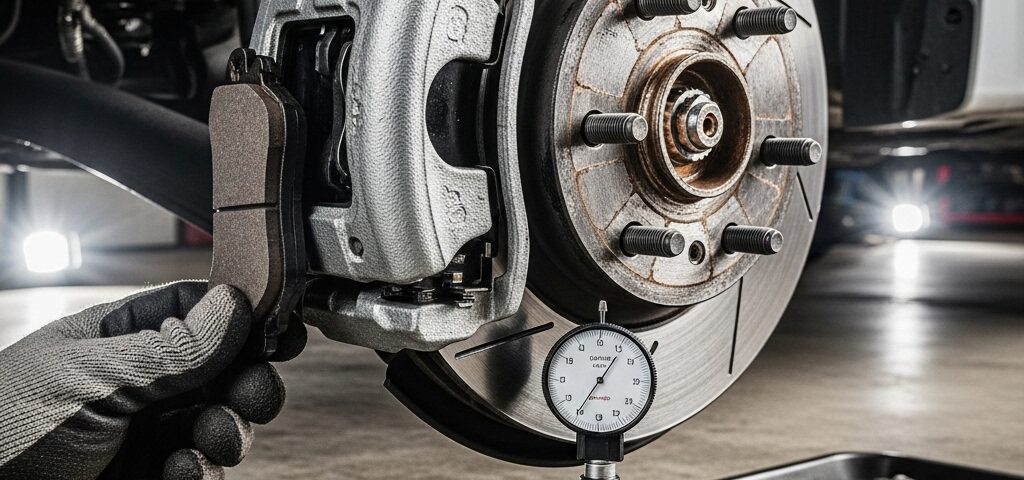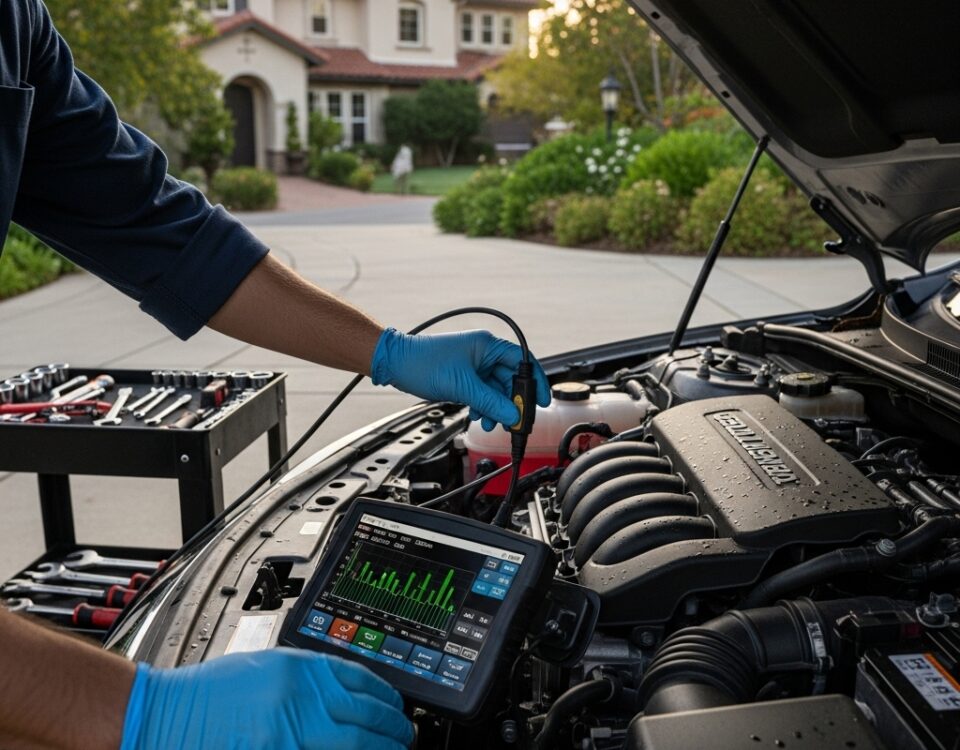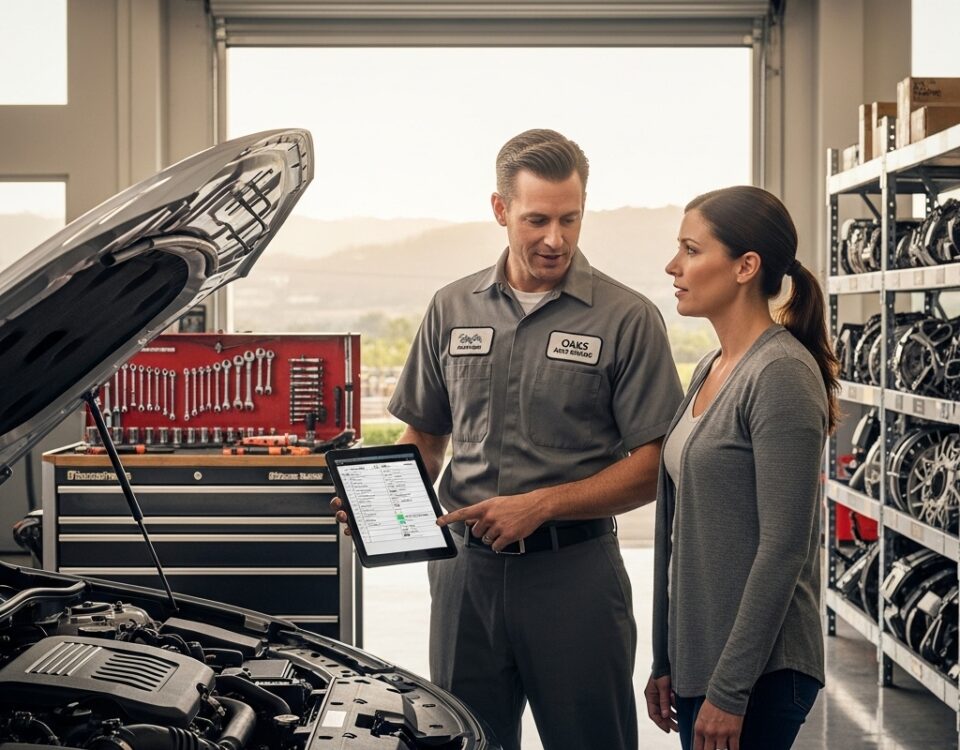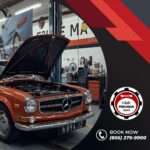
Why Choosing a Specialist Matters for German Auto Repair
October 3, 2025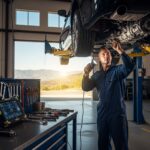
Transmission Repair Near Me in Thousand Oaks California
October 5, 2025Few components affect your confidence behind the wheel like your brakes. In Thousand Oaks, where the drive might shift from neighborhood streets to canyon descents and then onto the 101 in a single morning, brake pads and rotors do a lot of heavy lifting. When they are matched to your driving style and our local conditions, they deliver the quiet, predictable stops you expect. When they are not, you might notice squeals on cool mornings, vibration at highway speeds, or a brake pedal that feels less certain than it should. Helping drivers navigate these details is a big part of what we do, and it begins with translating brake talk into simple, useful guidance—much like the clarity people seek when they look for reliable car repair in the Conejo Valley.
Brake work is all about materials, heat, and consistency. The pads provide friction, the rotors dissipate heat, and the calipers apply force. If any part of that trio is misaligned with your usage, you feel it in the pedal and hear it in the cabin. Thousand Oaks adds its own twist with temperature shifts and grade changes. Early in the day, shaded neighborhoods can be cool and damp, which influences pad behavior; by afternoon, sun-baked streets turn up the heat, asking rotors to manage more thermal energy. Understanding those rhythms leads to smart choices that keep braking smooth and predictable.
Reading the signs: squeals, pulsation, and longer stops
Squeals often come from vibration between the pad and rotor, sometimes amplified by morning moisture. It may be harmless glazing, or it may signal that the pad compound isn’t a good fit for your pattern of short trips and light stops. Pulsation during braking typically points to rotor thickness variation or hotspots. That vibration you feel on the wheel or pedal after descending into town from the canyons is your cue to check the rotor surfaces and caliper slide behavior. Longer stopping distances may indicate pad wear, contaminated friction material, or hydraulic issues. Each symptom has a story; the job is to read it carefully before making changes.
A thorough brake inspection looks beyond pad thickness. We examine rotor runout, pad transfer layer, caliper movement, hose condition, and wheel bearing play. If a rotor has uneven pad material transfer, the fix might not be replacement; it could be a cleaning process and targeted bedding to restore even contact. Likewise, a pad that squeals may benefit from shims, recalibrated hardware, or a better-suited compound rather than a full overhaul.
Choosing the right pad compound for Thousand Oaks
Pad materials vary widely. Some compounds favor quiet operation and low dust, while others prioritize high-temperature performance for repeated hard stops. For most Thousand Oaks drivers, a balanced compound that remains stable during warm afternoons and behaves quietly on cool mornings is ideal. If you frequently head into the hills or carry heavier loads, we may lean toward a compound with stronger high-temperature control. The trick is to match the pad to your driving profile so the car feels composed during errands, commutes, and weekend outings alike.
We also consider rotor design. Vented rotors help manage heat in heavier vehicles, while high-carbon formulations can resist thermal cracking and reduce the likelihood of judder. When pads and rotors are well paired, the overall system runs cooler, quieter, and more consistently. It’s the difference between a braking system that just works and one that feels refined.
Proper bedding: the overlooked step
Bedding new pads and rotors isn’t about hard stops; it’s about controlled heat cycles that transfer an even layer of pad material to the rotor face. This layer is what your pads actually grip during braking. Without proper bedding, you might experience uneven friction, noise, or early pulsation. We plan a careful bedding process that suits your route and your schedule, often recommending a sequence of moderate stops on lightly traveled roads to build the transfer layer without overheating anything.
For drivers who spend a lot of time on the 23 or dropping into the canyons, bedding becomes even more important. The system needs to be ready for sustained braking under higher temperatures. Taking a few extra minutes to perform this step correctly pays off in quieter, smoother stops and longer component life.
Brake fluid and the hydraulics behind the pedal
Pads and rotors do the friction work, but brake feel is also shaped by fluid health and hydraulic integrity. Brake fluid absorbs moisture over time, which lowers its boiling point and can lead to a soft pedal during heavy use. In Thousand Oaks, with warm afternoons and occasional spirited drives down grade, keeping fluid in good condition is essential. We also check for hose swelling, caliper piston behavior, and master cylinder consistency. If any of these components are marginal, you can chase pad and rotor combinations endlessly without getting the pedal feel you want.
Small details, like clean hardware and properly lubricated slide pins, are quiet heroes. Sticking slides cause uneven pad wear and can mimic rotor issues. Thorough preparation and attention to these subtleties prevent premature problems and help your brakes operate as a cohesive, confident system.
Driving habits that help your brakes last
A few mindful habits extend the life of pads and rotors. Avoid resting your foot on the pedal during long downhills; instead, use firm, periodic braking to manage speed and give the system a chance to shed heat between applications. When exiting the freeway, avoid sitting stationary with the brakes clamped hard after a spirited run; if it’s safe, let the car roll gently or stop with light pressure to reduce the risk of imprinting pad material on hot rotors. These small choices help maintain smooth rotor surfaces and consistent braking behavior.
City driving presents different challenges. Short, frequent stops can lead to glazing if the pads never reach an effective operating temperature. When possible, plan routes that allow steady speeds, and remember that a well-bedded system resists glazing better in these conditions. A little forethought preserves that satisfying, linear pedal feel.
Inspection rhythm that respects your routine
We build brake checks into your broader maintenance plan, aligning inspections with oil services or tire rotations so you don’t add extra appointments to your calendar. During those visits, we measure pad thickness precisely, examine rotor surfaces under proper lighting, and verify even hardware movement. If something needs attention soon, we outline options and timing so you can plan without stress. If everything looks healthy, you leave with the reassurance that your brakes are ready for the next season of driving.
In the middle of this approach is a simple truth: good car repair is predictable. Prediction comes from patterns and careful observation. By pairing what we see on your car with what we know about Thousand Oaks roads and weather, we give you a braking system that behaves the way you expect—day after day.
Frequently Asked Questions
Q: How do I know if my brake pads or rotors actually need replacement?
A: We look at measured pad thickness, rotor condition, and how the brakes feel under controlled stops. If rotors are smooth and within spec, and pads have material left but are noisy due to glazing, a deglazing and proper bedding may restore performance without immediate replacement. Clear measurements and a road test guide the decision.
Q: Why do my brakes squeal more in the mornings?
A: Cool, damp mornings in shaded neighborhoods can increase pad vibration and temporarily change friction behavior. If the noise fades as the day warms, it may be harmless. If it persists, we evaluate pad compound, hardware condition, and transfer layer quality to find a quieter, lasting solution.
Q: What causes brake pulsation on downhill stretches?
A: Heat builds during long descents. If pads leave uneven material on hot rotors, you’ll feel a rhythmic pulse as the brakes are applied. Proper rotor quality, pad choice, and careful bedding help prevent this. If pulsation appears, we measure rotor thickness variation and address the root cause.
Q: Do I need performance pads for canyon drives?
A: Not necessarily. Many balanced compounds handle spirited use while remaining quiet and civil in daily traffic. We match pad and rotor choices to your driving profile so you get confident stops without sacrificing comfort or longevity.
Q: How important is brake fluid in pedal feel?
A: Very. Brake fluid condition influences pedal firmness and consistency under heat. Moisture-contaminated fluid can boil sooner, causing a soft pedal during hard or prolonged braking. Keeping fluid healthy is central to a confident, repeatable brake feel.
Q: Can uneven tire wear affect how my brakes feel?
A: Yes. Tires with uneven wear can amplify vibration and change stopping behavior, making brake issues feel worse than they are. We evaluate the whole system—tires, suspension, and brakes—to ensure a smooth result.
Ready for quieter, smoother stops in Thousand Oaks?
If your brakes are trying to tell you something—squeals, vibration, or a pedal that feels a little off—let’s address it with care matched to local roads and your driving style. You deserve a car that inspires confidence every time traffic tightens or the road turns downhill.
Reach out to schedule an inspection and a tailored plan for your pads and rotors. For precise, locally informed car repair, we’re ready to help you stop smoothly and drive with peace of mind.


